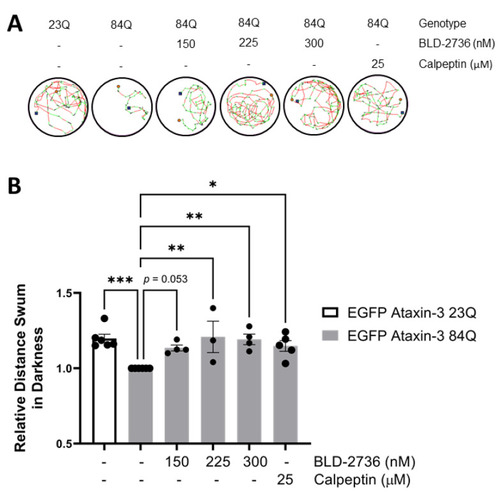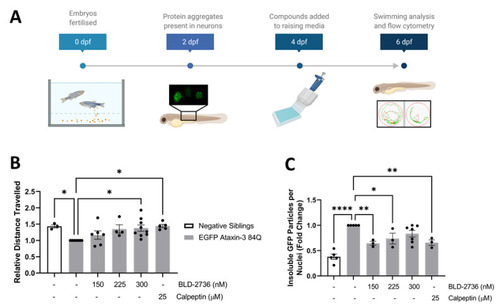- Title
-
A Novel Calpain Inhibitor Compound Has Protective Effects on a Zebrafish Model of Spinocerebellar Ataxia Type 3
- Authors
- Robinson, K.J., Yuan, K., Plenderleith, S.K., Watchon, M., Laird, A.S.
- Source
- Full text @ Cells
|
Treatment with BLD-2736 from 1 to 6 days post-fertilization improves SCA3 zebrafish swimming performance. (A) Representative trajectories displaying the distance swum during motor performance assays at 6 days post-fertilization. (B) Transgenic zebrafish expressing EGFP-fused human ataxin-3 with 84 polyglutamines swim shorter distances than zebrafish expressing EGFP-fused human ataxin-3 with 23 polyglutamines. Treatment with calpain inhibitors (BLD-2736 or calpeptin) improved the distance swum. All data are presented as mean ± SEM, n = 12–24 larvae were examined per group. * represents p < 0.05, ** represents p < 0.01, *** represents p < 0.001. PHENOTYPE:
|
|
Treatment with BLD-2736 from 1 to 6 days post-fertilization reduces the presence of ataxin-3 protein species. (A) Representative scatterplots showing flow cytometric detection of detergent-insoluble EGFP-fused ataxin-3 particles following calpain inhibitor treatments. (B) The number of detergent-insoluble EGFP particles relative to nuclei was decreased following treatment with calpain inhibitors. (C) Representative western blot showing the presence of full length and cleaved ataxin-3 protein species. (D) Calpain inhibitor treatments were found to decrease the presence of full length ataxin-3 species in a dose-dependent manner. (E) Calpain inhibitor treatments also produced a decrease in the presence of cleaved ataxin-3 species, as detected by Western blotting. All data are presented as mean ± SEM. Each data point represents a single experimental replicate, where samples were pooled from n = 12–20 zebrafish larvae. * represents p < 0.05, ** represents p < 0.01, *** represents p < 0.001, **** represents p < 0.0001. |
|
Delayed treatment with BLD-2736 or calpeptin produced a therapeutic benefit, despite administration after the onset of disease pathology. (A) Timeline displaying the onset of disease pathology at 2 dpf, treatment administration at 4 dpf, and examination of treatment efficacy at 6 dpf. (B) Treatment of SCA3 zebrafish from 4 to 6 dpf improved the distance swum when compared to vehicle treated SCA3 zebrafish. Swimming analysis was performed on n = 12–25 larvae per group. (C) Post-symptomatic treatment with calpain inhibitors produced a detectable decrease in the presence of detergent-insoluble EGFP-fused ataxin-3 particles. Each data point represents an experimental replicate, where n = 12–20 larvae were pooled together. All data are presented as mean ± SEM. * represents p < 0.05, ** represents p < 0.01, **** represents p < 0.0001. |
|
Treatment with BLD-2736 increased the activity of the autophagy protein quality control pathway. (A) Immunoblotting of LC3II revealed changes in the levels of LC3II relative to GAPDH across treatment groups. (B) Quantitative analysis of the ratio of LC3II to GAPDH was found to be significantly increased in larvae treated with 300 nM BLD-2736 when compared to larvae treated with the autophagy inhibitor chloroquine and 300 nM BLD-2736, indicating increased synthesis of LC3II and induction of autophagy. Protein lysates were produced from pooled samples of n = 12–20 zebrafish larvae. Each data point represents an independent experimental replicate. All data are presented as mean ± SEM. * represents p < 0.05, ** represents p < 0.01, **** represents p < 0.0001. |




